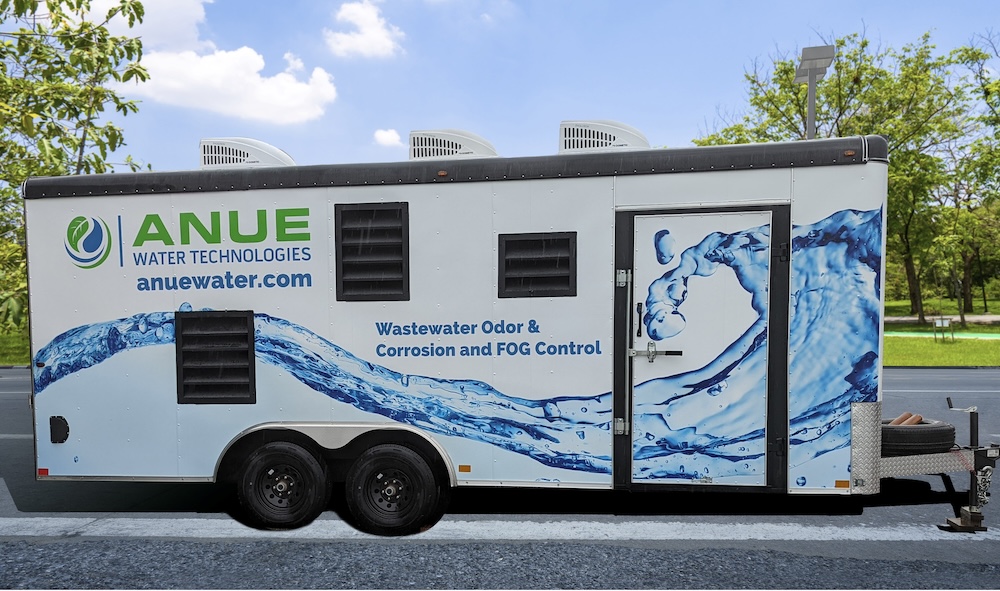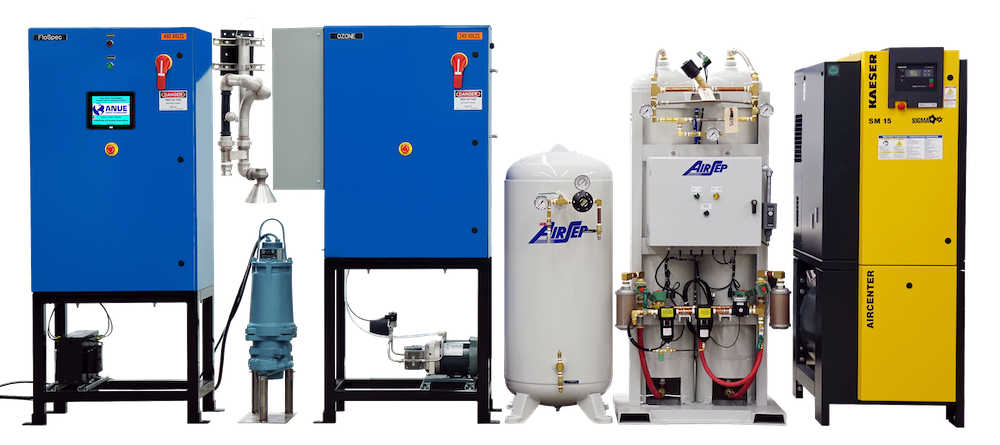Anue Water Technologies is working with municipalities to replace their use of wastewater treatment chemicals for corrosion and odour control with eco-friendly oxygen infusion at no capital expense, targeting a 20% reduction in operating cost.

Greg Block, Chief Operating Officer at Anue Water Technologies
To learn more about Anue’s oxygen infusion systems, Darby from H2O Global News spoke to Greg Block, Chief Operating Officer at Anue Water Technologies.
For a long time, wastewater systems have been affected by odours and corrosion, which is understandable since they carry a lot of waste. Controlling the odours is the main priority, but the corrosion has the potential to cause more environmental harm and real damage to the system and economy.
This damage can be in the form of broken pipes or other equipment, which require repairs and replacements, and can lead to unexpected release of hazardous material that is difficult, if not impossible, to contain or recover.
Hydrogen Sulfide & Corrosion
The formation of hydrogen sulfide (H2S) and its compounds can lead to odours and corrosion in industrial systems. Wastewater containing sulfur compounds provides the molecular basis for the generation of H2S. When oxygen (O2) is absent and sulfites and sulfates are present, colonies of microorganisms on the inner walls of the collection system called the slime layer, give rise to sulfate-reducing bacteria (SRB). These bacteria are unable to utilise the sulfur component, thereby allowing it to react with water and free protons (H+), leading to the production of H2S.
Once formed, H2S can enter the atmosphere and reach receptors via the atmosphere-collection system interface. This gas, which is odourless, colourless, and highly toxic, is also corrosive to certain metals and is heavier than air, allowing it to accumulate in areas with limited ventilation such as wells and manholes. The effects on humans at varying concentrations in comparison with the ambient air are shown in the table below.
Table 1: H2S Health Effects at Different Concentrations (Source: Anue Water Technologies)
| Concentration (ppm) | Physiological Effects |
| 0.1 – 3 | Odour threshold |
| 3 – 10 | Offensive odour |
| 10 – 50 | Headache, nausea, and throat & eye infection |
| 50 – 100 | Eye injury |
| 100 – 300 | Conjunctivitis, respiratory tract infection, and olfactory paralysis |
| 300 – 500 | Pulmonary edema and imminent threat to life |
| 500 – 1000 | Strong nervous system stimulation and apnea |
| >1000 | Immediate collapse with respiratory paralysis |
When H2S is present (along with moisture and oxygen) on certain metals like concrete or steel, it can be a serious problem. This is particularly true in places such as the headspace of pipes where there is access to the atmosphere, and bacteria are present to turn the H2S into sulfuric acid, which is corrosive and can cause damage to the infrastructure.
Throughout history, odour and/or corrosion have been mitigated by either vapour phase or liquid phase methods. Scrubbers, a form of vapour phase treatment, do not provide corrosion prevention. However, certain liquid phase techniques can offer corrosion control.
A widely accepted approach to treating wastewater in the collection system is to dose chemicals into the system. This is usually done by pumping a steady and consistent amount of chemicals from a large tank to a manhole or pump station. The purpose of this is to interact with the compounds in the wastewater that create odours or to prevent their formation and/or eliminate them from the solution.

Cleantech and Onsite Oxygen Infusion
When considering viable and environmentally friendly ways to address odour and corrosion in collection systems, oxygen and ozone are at the forefront. Oxygen is plentiful, representing approximately 21% of the atmosphere, and has the capacity to be converted to ozone. Together, these two gases have been proven to be an efficient, safe, and affordable method of treatment. Ozone has a strong capability to break down H2S by transforming it to sulfites and sulfates upon contact.
Ozone’s antimicrobial properties can help diminish the quantity of SRB and other microorganisms on pipe walls. Additionally, oxygen is produced as a product of the reaction and this reinforces the oxygen component of the treatment gas mixture. This empowers secondary treatment by substantially raising dissolved oxygen and permits for more extensive utilisation of infused treatment gases.
The oxidizing properties of oxygen and ozone are formidable, which has led to worries about the infrastructure in wastewater systems being damaged. However, this is unlikely to be an issue when liquid infusion is employed due to the abundance of reactants in the liquid and the ratio of liquid volume to pipe surface area per unit pipe length.
Anue’s Oxygen and Ozone Treatment
Anue’s FORSe® series technology was created to treat wastewater corrosion and odour in force mains and lift stations. These systems are designed to solve odour and corrosion problems at their source.

The most crucial step in the treatment process is the mass transfer of oxygen into the water phase of the force main. Anue’s oxygen delivery methods are proven to effectively treat and prevent corrosion and odour in the Main Lines. This process not only provides liquid phase corrosion prevention but vapour phase odour control as well. There are multiple infuser options, selected on the basis of system hydraulics and chemistry parameters, including pressure, flow, detention time and sulfide/biological oxygen demand (BOD) levels.
Anue’s oxygen delivery technology provides beneficial O2 to the force main, creating a positive dissolved oxygen level, and eliminating the corrosive anaerobic SRB activity thereby reducing costly maintenance and repair while extending the life of collection systems.
Anue’s FORSe® is a Success!
Anue noticed that a municipality was combatting hydrogen sulfide odours and corrosion with an ever-increasing feed rate of 125 gallons per day of calcium nitrate. There was also an inability to control price increases of the chemical— the expenditure was exceeding $11,000 per month plus an additional $1,200.00 per month administration fee. Anue was brought in to provide a better solution! Firstly, they completed a site survey and comprehensive engineering analysis. They then deployed a mobile system to infuse pure oxygen into the force main and mitigated hydrogen sulfide levels to less than 5 ppm. Anue’s Total Solutions Program provided a safer and greener environmental approach, replacing the use of chemicals and associated labor/handling costs with an oxygen and ozone infusion service at a flat monthly service fee. This also resulted in significant operational cost savings for the municipality’s H2S treatment and corrosion inhibition program.
Another application issue that Anue addressed was when a newly built gated development had residents complaining of hydrogen sulfide odours. The site developer evaluated numerous chemical products, none of which were a viable solution due to performance cost, handling and freeze potential. And therefore, monthly chemical costs would exceed $20,000.00.
Anue stepped in and deployed a containerized FORSe® 2 system to infuse pure oxygen into the force main. This ensured that hydrogen sulfide levels were brought under control, and the residents were happy with the results. Clients also received flat monthly billing, providing stability versus the experience with chemicals – which typically include fluctuations in monthly chemical spend and freezing issues. The outcome was that the Total Solutions Program service provided a 35% annual savings over the previously evaluated programs, which was highly beneficial for Anue’s clients.
Conclusion
Anue Water Technologies acknowledges the development of H2S gas and why it is hazardous and destructive to the pipes and the people who maintain them. They are also aware that chemical compounds can impede the formation of H2S gas, yet there are restrictions on the storage, handling, and chemical leftovers reaching the waste treatment plant in addition to yearly price increases. It is evident that oxygen and ozone are both successful and safe for the environment without causing precipitation on the pipe surfaces or additional chemical remnants downstream at the waste treatment facility.
Thanks to Anue’s technology, the production of highly concentrated oxygen and ozone can be created on-site for straightforward infusion into the waste stream. This avoids the formation of H2S, shielding the pipes and the personnel maintaining them while guaranteeing effective odour control.
Learn more: https://anuewater.com







